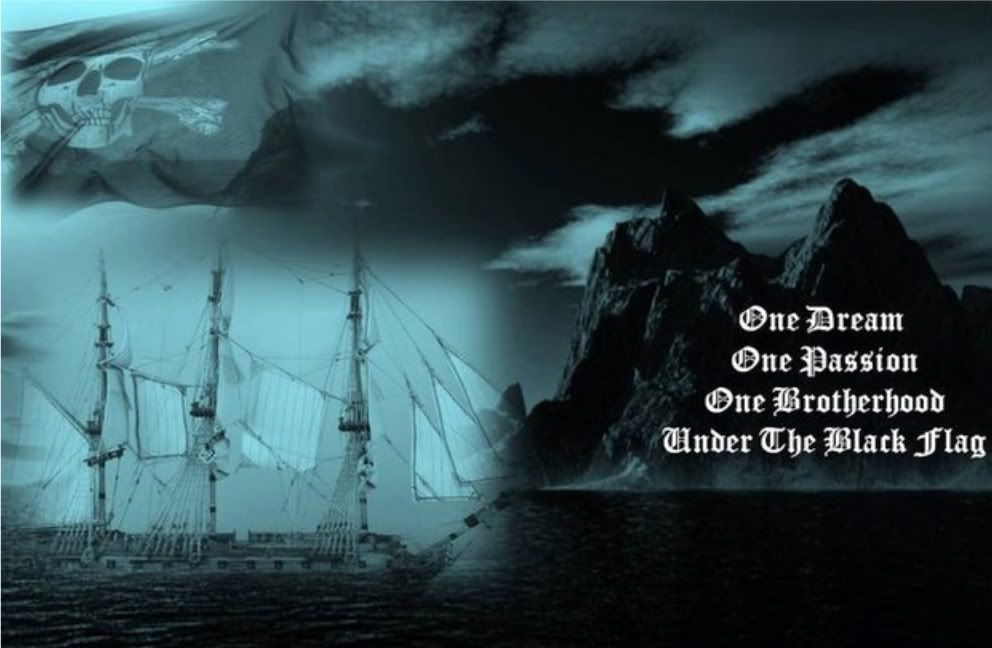Lady Pirates: The Creole And The Cinquantain by Pauline
articles, Lady Pirates: The Creole And The Cinquantain by Pauline 2:55 π.μ.I'm going to go way out on the crosstrees and say that freebooters of every era probably got a fair amount of tail. There were the usual doxies to be had at pirate ports, and there were probably sea rovers who worked out relationships with these women, tenuous though they may have been. Away from home, stories are told of middle class and wealthy women in captured cities giving up their charms either as a way of securing freedom for themselves and/or loved ones or because, like those famous Roman patricians who chased gladiators, they had the itch for a hot buccaneer. Of course there was always rape and that was probably far more common than many of the historians would like to have us believe. But I won't count that here. Rape, however satisfying it may be for the assailant, is an act of violence. Sure, it mimics the sex act; so does plunging a cutlass into an enemy's flesh. But I digress.
What you rarely hear of is the traditionally married sea rover, the stories of Blackbeard's twenty odd wives not withstanding. And this is just another reason why I am particularly fascinated with the buccaneer we spoke of yesterday. Laurens de Graff, it seems, had not one but two not only reasonably stable but legal relationships bound by recognized marriage. That doesn't mean that these marriages wouldn't have given most respectable Europeans at the time pause, however.
De Graff's first wife is a shadowy figure. Her name is even debated among historians. She is listed sometimes as Petronila de Guzman; clearly a Spanish name. More often, though, she is called Francoise Petuline de Gusman or Gusmaine. This name would indicate a French background. The historians who take the Spanish nativity side point out that de Graff sailed for Spain for many years and when the lady's name enters the historical record she is already de Graff's wife living on the French held island of Tenerife. I would say that the addition of "Francoise" makes that argument open for question. Why is "Francisca" not included in her Spanish name?
What is interesting to me is that Francoise is clearly a woman of some standing. Bar girls don't run around with two are three names that include the appended "de". She was most probably a plantation born Creole which means a person of European ancestry born in the New World. (A certain pop stars' recent co-opting of the word to mean a person of mixed race will be ignored for the purpose of historical accuracy.) Creolo is the word used by the Spanish. If that is the case de Graff would have been required to court her in a relatively traditional way before marriage could even be considered. Of course a shortage of suitors in some of the more remote areas might make any guy with a few pieces of eight in his pocket look attractive but appearance would need to be kept up. And who knows, maybe Francoise and Laurens were actually in love.
De Graff clearly felt some obligation to Francoise, despite the fact that it appears they did not live together for any length of time. In 1683, when he was considering an offer from the English to move his home port to Jamaica and accept a commission from that island, de Graff made sure to look out for his wife. Part of the written deal stipulated that Francoise be transported from Tenerife to Jamaica at British expense. A new, buccaneer friendly French Governor in Saint Domingue put the brakes on de Graff's deal with the English. Francoise, apparently, stayed at Tenerife. There is no documentation that the couple ever had children.
Then, ten years later, a new kind of woman in Saint Domingue put the brakes on any marital happiness Francoise might have known.Between 1690 and 1695 Louis XIV got the notion to "seed" his predominantly male island of Saint Domingue with "ladies". It was time for the wild boucaniers to stop all this distasteful matelage, settle down with women and make some French citizens. And while we're at it, let's get rid of some of these prostitutes. Voila. The first shipment of fifty already experienced girls appears on the shores of Saint Domingue - probably at Petit Goave - around 1691.
These initial fifty pioneers were known as La Cinquantaine (the fifty ladies) and among them was a colorful girl with a colorful name: Marie-Anne Dieuleveult. Her name literally translates as "God's will" in a provincial form of French probably common to the Caribbean. This leads me to believe that it was not her real name but a professional moniker that said, essentially, it's God's will that you pay me to sleep with you. By the time she met de Graff in a Petit Goave punch house, she was allegedly married to another buccaneer.
We know with certainty, based on a brief note in Exquemelin's writings, that Marie-Anne and Laurens hooked up in 1693. At the time he was still married to Francoise but we know nothing factual about Marie-Anne's marital status. A fictional fog has taken hold of Marie-Anne and there is more than one website (Wikipedia included) that informs us she was a pirate along side de Graff, Captaining his ship when he was wounded and even killed at sea. In this not very original tale Laurens kills Marie-Anne's husband in a bar fight. Marie-Anne challenges Laurens then and there but he "succumbs", unwilling to fight with a woman. Guess what happens next? They fall madly in love. *swoon*
Your humble hostess enjoys romance as much as the next gal but it's like chocolate: moderation prevents puking. To me, these kind of stories diminish the real women who went to sea and sometimes fought alongside their men - or even alone. Marie-Anne may have sailed with de Graff at some point but it's a surety that she never took the helm and probably never participated in raids. Exquemelin, always ready to report a sensational story, would have made note of it if she had no doubt.
The truth doesn't take away from Marie-Anne's buccaneer nature. She came to Saint Domingue in a rough and tumble time when women were few and far between. She carved out a life for herself and managed, through luck or savvy or both, to snag a capable and handsome sea rover. Plunder is plunder whether it's Spanish silver or a good man.
By 1695 de Graff was divorced from Francoise and married to Marie-Anne. Of course the legality of the whole thing is questionable but in the New World things were done differently than they were in London, Paris or Madrid. Francoise fades from history all together. Marie-Anne bears Laurens at least one child. Church records in the Quartier Marin in Saint Domingue list the birth of a daughter, Marie-Catherine de Graff.
During France's war with the combined forces of England and Spain, Marie-Anne was again called to live by her wits. She was taken hostage by the Spanish, probably snatched from her husband's plantation in one of the raids that were such a common part of war in the area, and held for ransom in Veracruz. Of course the memory of her husband's sacking of that city was fresh and if the authorities knew who she was it must be assumed that she was treated to special attention. Her time in captivity is lost to history, but she was returned to Saint Domingue before her husband set off for Louisiana in 1699.
The tall tales of Laurens and Marie-Anne settling along the Mississippi and continuing their piratical lifestyle are just that: tall tales. De Graff's last will was executed in Saint Domingue, where he almost certainly died. Dated the year of his death, 1704, it leaves his entire and considerable estate to Marie-Anne and their daughter Marie-Catherine.
In the end both of de Graff's women, the Creole and the Cinquantaine, had it tough. Not, in all fairness, tougher than most of their sisters in the wild and lawless New World of the time, but tough nonetheless. I'm sure they both would have been fascinating to talk to. Francoise over a pot of heady coffee; Marie-Anne over a bottle of blood red Madeira. Salute.
http://paulinespiratesandprivateers.blogspot.com/2010/04/lady-pirates-creole-and-cinquantaine.html













